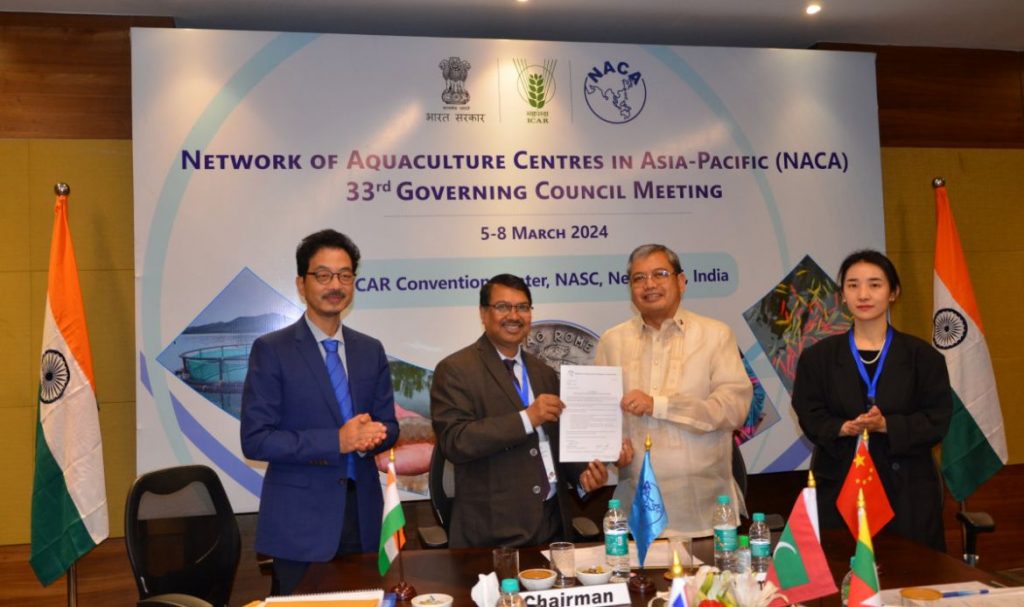
Ms. GT Mabilog
The Network of Aquaculture Centers in Asia-Pacific (NACA), in its 33rd Governing Council Meeting in New Delhi, India, elected Dr. Eduardo Leaño as its incoming Directer General starting May 2024 last 06 March 2024. Dr. Leaño will take on a five-year term, succeeding Dr. Huang Jie.
Dr. Leaño is a graduate of Master of Science in Fisheries of the University of the Philippines Visayas (UPV). He completed his Bachelor of Science in Inland Fisheries at Central Luzon State University and earned his PhD in Applied Biology from the City University of Hong Kong.
At present, he is NACA’s Senior Program Officer for Health and Biosecurity Program, and Food Security, Safety, and Certification Program. He was previously a research scientist in the Aquaculture Department of the Southeast Asian Fisheries Development Center (SEAFDEC). Moreover, he was a research fellow at the Taiwan Fisheries Research Institute, and research fellow and adjunct professor at the National Taiwan Ocean University.
Throughout the course of his career, Dr. Leaño has successfully published seven books on aquaculture and aquatic animal health. His track records also includes publications of 50 scientific articles in various national journals, proceedings, and book chapters. (With sources from NACA)
Source: https://www.upv.edu.ph/index.php/news/upv-alumnus-is-incoming-naca-director-general
Alumni Milestones
UP PGH Department of Medicine Batch MaxIMus achieves 100% passing rate in the 2024 PSBIM
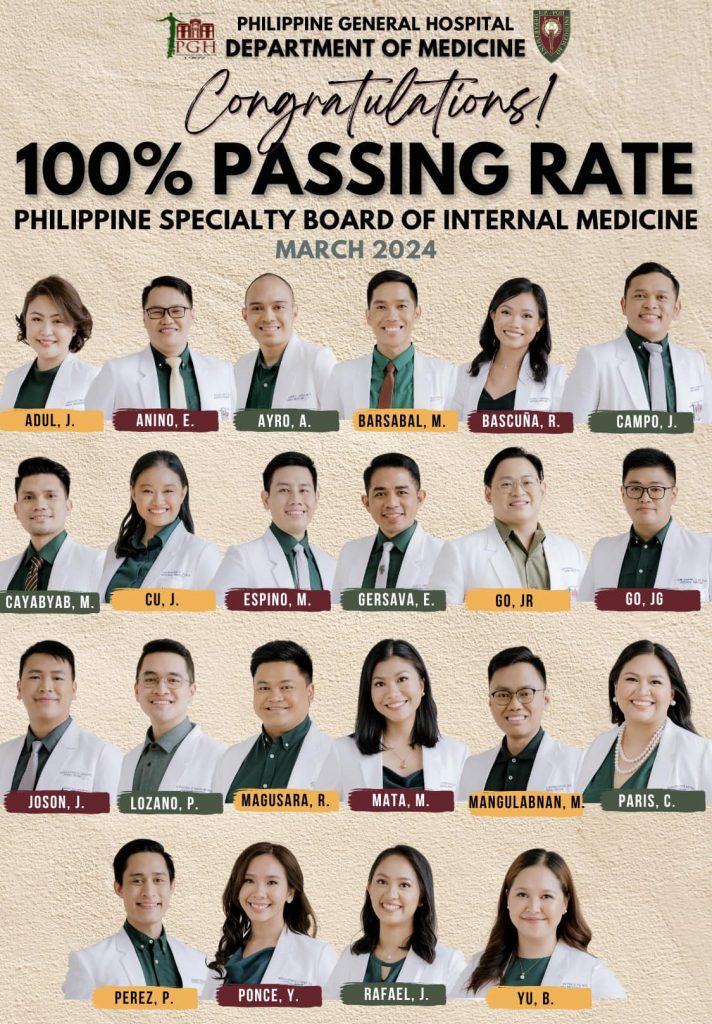
The UP PGH Department of Medicine congratulates Batch MaxIMus for the 100% passing rate in the 2024 PSBIM:
Joanna Felicita Adul
Eladio Anino V
Aaron Joseph Ayro
Marc Lharen Barsabal
Rosa Silvana Bascuna
John Thaddeus Campo
Myron Cayabyab
Joanna Pauline Cu
Marvin Roi Espino
Emerald Gersava
James Robert Go
Jose Gabriel Go
Josiah Juan Alfonso Joson
Patrick Nicolo Mari Lozano
Regiel Christian Mag-usara
Marvin Mangulabnan
Maria Katrina Mata
Chelsea Colleen Paris
Paul Miguel Perez
Ysabella Veniece Ponce
Janine Bianca Marie Rafael
Beverly Christine Yu
May you continue to be in pursuit of excellence and respond to the country’s health needs. Padayon!
Source: UP PGH Department of Medicine Facebook
UP Baguio Department of Biology congratulates its alumni who passed the 2024 Philippine Academy of Microbiology (PAM) Certification Examination


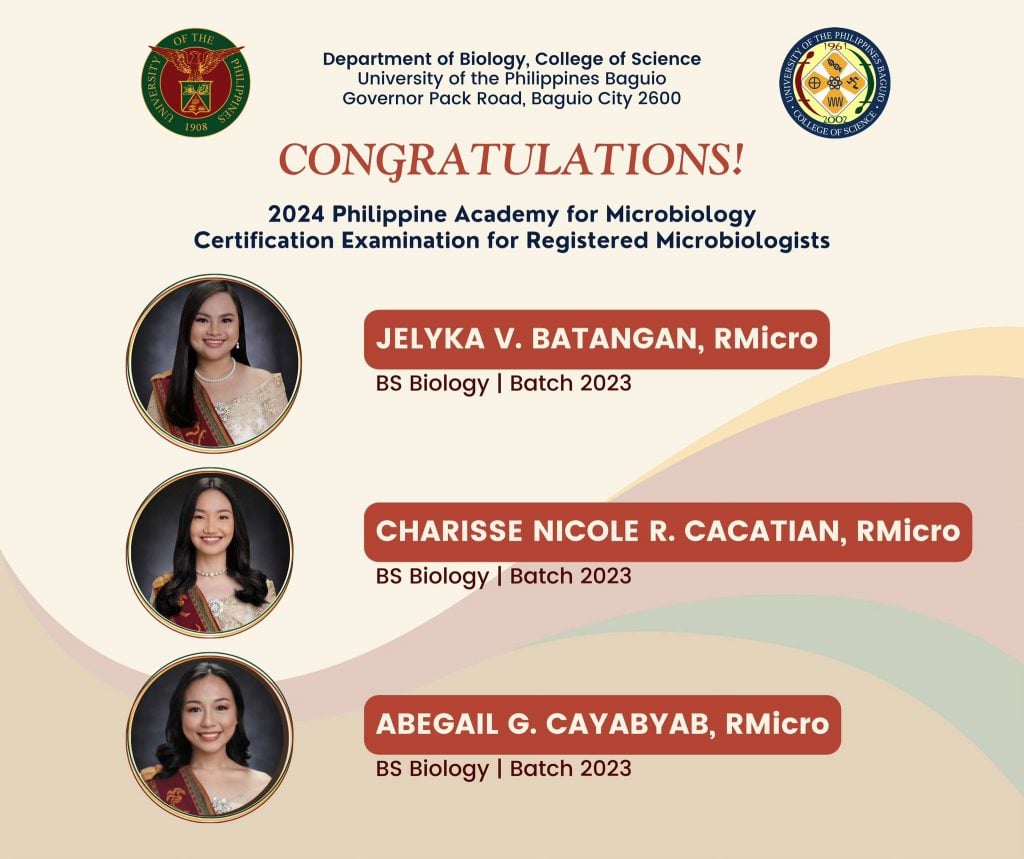
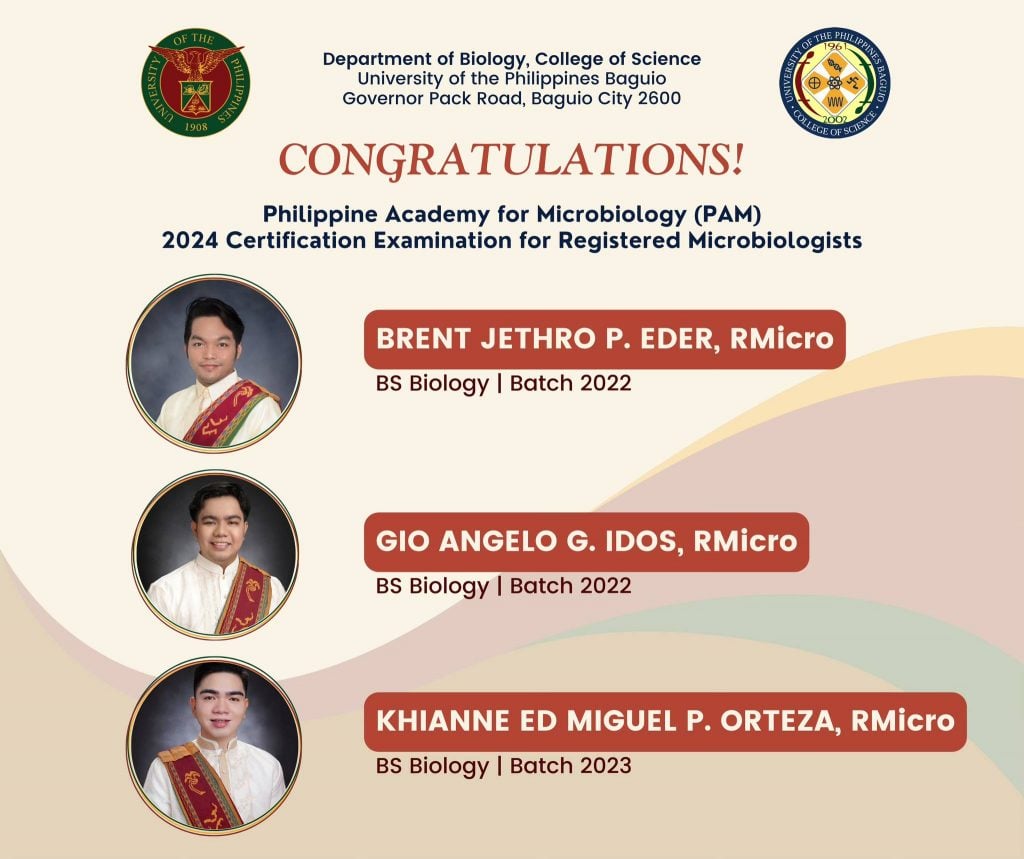

📣EXCITING NEWS!📣
The Department of Biology, UP Baguio congratulates our BS Biology alumni who passed the 2024 Philippine Academy of Microbiology (PAM) Certification Examination for Registered Microbiologist held last January 20-21, 2024. We sincerely wish you all the best in your future endeavors.
May this monumental achievement also serve as inspiration for our future microbiologists, scientists, and medical professionals, as well as encourage them to consistently strive for both honor and excellence.
Padayon, mga Iskolar ng Bayan! ✊🏼💯
Source: Department of Biology, UP Baguio Facebook
UP-Diliman graduate grand champion of 51st Nihongo Speech Contest
Dolly Dy-Zulueta

MANILA, Philippines — Jacob Fuentebella, a University of the Philippines (UP)-Diliman graduate who now works as a Korean Account Associate, is the grand champion of the 51st Nihongo Speech Contest, which took place at Shangri-La Plaza in Mandaluyong City last February 24.
The speech competition was one of the highlights of the Nihongo Fiesta 2024 organized by Japan Foundation Manila.
Fuentebella, who represented Bulacan, bested eight other finalists from all over the Philippines who came together to showcase their talents and skills in communicating their thoughts in Japanese. Fuentebella’s speech, as translated (“People-to-People Connections Through Foreign Language Studies”), talked about his language learning journey, starting from Korean, and now venturing into Japanese, aiming to inspire others.
Securing the second place was Erina Sotoya (Cebu), with her piece called “Irreplaceable Person,” which she used to share how her memories with her father shaped her deep appreciation for present connections.
Third place went to Anferee Tizon (Taguig), a 4th year BA Communications student at Adamson University, with his speech titled “Not All Coffee Tastes Bitter,” which reflected his personal journey on friendships and how the lessons he learned shaped his current perspective and attitude towards people, similar to how his taste for coffee has changed.
The Special Jury Award was given to Niño Raphael Mesajon (Davao), a Grade 12 student from Philippine Nikkeijin Kai International School, for his speech “Truth Beyond First Sight.” It talked about how his perspective changed during a visit to a Lumad community, leading him to question the true meaning of living a good life.
The winners were chosen based on Content (originality, organization and impact), Delivery (voice and manner) and Language (appropriateness and correctness).
Fuentebella will be joining the study tour hosted by the Japan Overseas Enterprises Association, with airfare sponsored by the Japanese Association Manila Inc. and the Japanese Chamber of Commerce and Industry of the Philippines Inc.
The 51st Nihongo Speech Contest was one of the highlights of the Nihongo Fiesta 2024 organized by Japan Foundation Manila. The Nihongo Fiesta stands as a tradition serving not only as an event but as a celebration that fosters deeper connections between Japan and the Philippines. It provides a fertile ground for the flourishing community of Nihongo speakers and enthusiasts, welcoming individuals from all walks of life, from eager language learners to seasoned professionals, to take part in an immersive arts and cultural experience.
Nihongo Fiesta 2024 also featured the “Minna no Nihongo Fiesta,” a captivating display of photos submitted by educational institutions across the Philippines, giving the audience a unique glimpse into the diverse facets of Japanese cultural appreciation in the Philippines. Meanwhile, attendees were treated to a performance by the UP Philippines-Japan Friendship Club (UP Tomo-Kai), showcasing the rich tapestry of Japanese culture.
Capping off the event was a performance of the Ryukyu Buyo, an Okinawan traditional dance performance, as Nihongo Fiesta 2024 turned out to be a celebration of language, culture and creativity.
Source: https://www.philstar.com/lifestyle/arts-and-culture/2024/03/03/2337784/diliman-graduate-grand-champion-51stnihongospeech-contest
UP Cebu Professor Conferred Outstanding Individual Award by the City
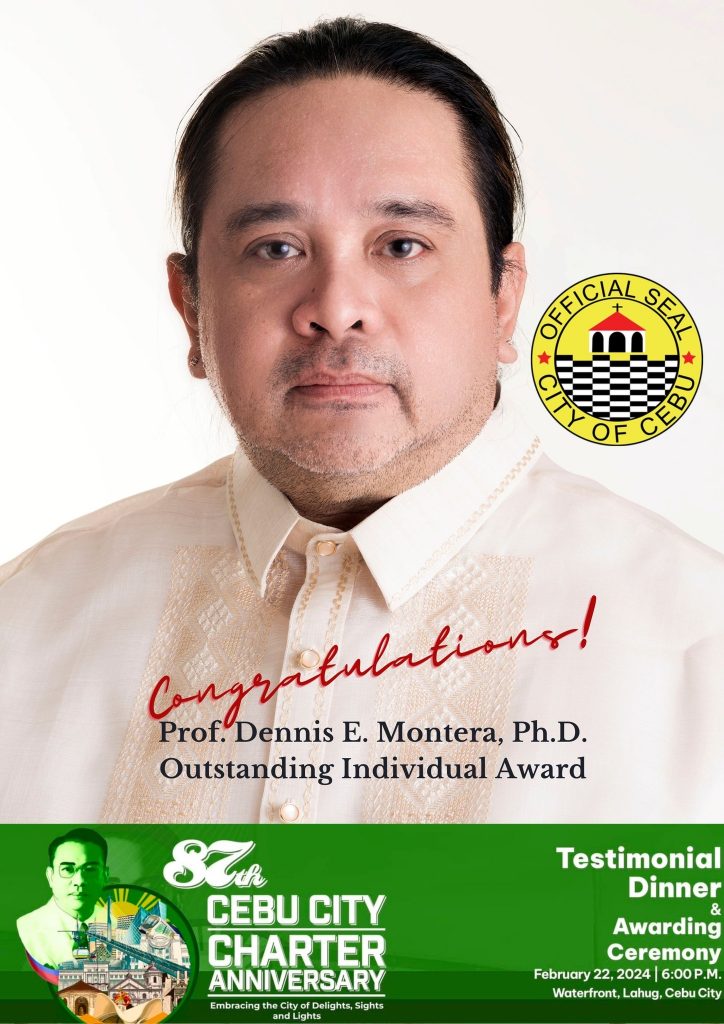
UP Cebu Fine Arts Program Coordinator Dr. Dennis E. Montera was conferred the Outstanding Individual award by the City of Cebu on the occasion of its 87th City Charter Anniversary celebration held at the Pacific Ballroom of Waterfront Hotel and Casino on February 22, 2024.
Prof. Montera was recognized in appreciation of his dedication to the visual arts community of Cebu serving as an educator, accomplishments as an artist, and a driving force in advancing the interest of the visual arts community.
The city government of Cebu recognized outstanding individuals, institutions, and the Mayor’s Special Awardees for their significant contributions to the betterment of Cebu City. The awarding ceremony and testimonial dinner were led by the city’s chief executive, Mayor Michael Lopez Rama.
Source: University of the Philippines Cebu Facebook
Congratulations to Dr. Amabel S. Liao, the new president of Western Philippines University

Congratulations to DR. AMABEL S. LIAO, the new president of Western Philippines University!
Source: Western Philippines University Facebook
Accelerating S&T in PH through Research: High-Impact Studies Led by UP Scientists in 2023
By Eunice Jean Patron
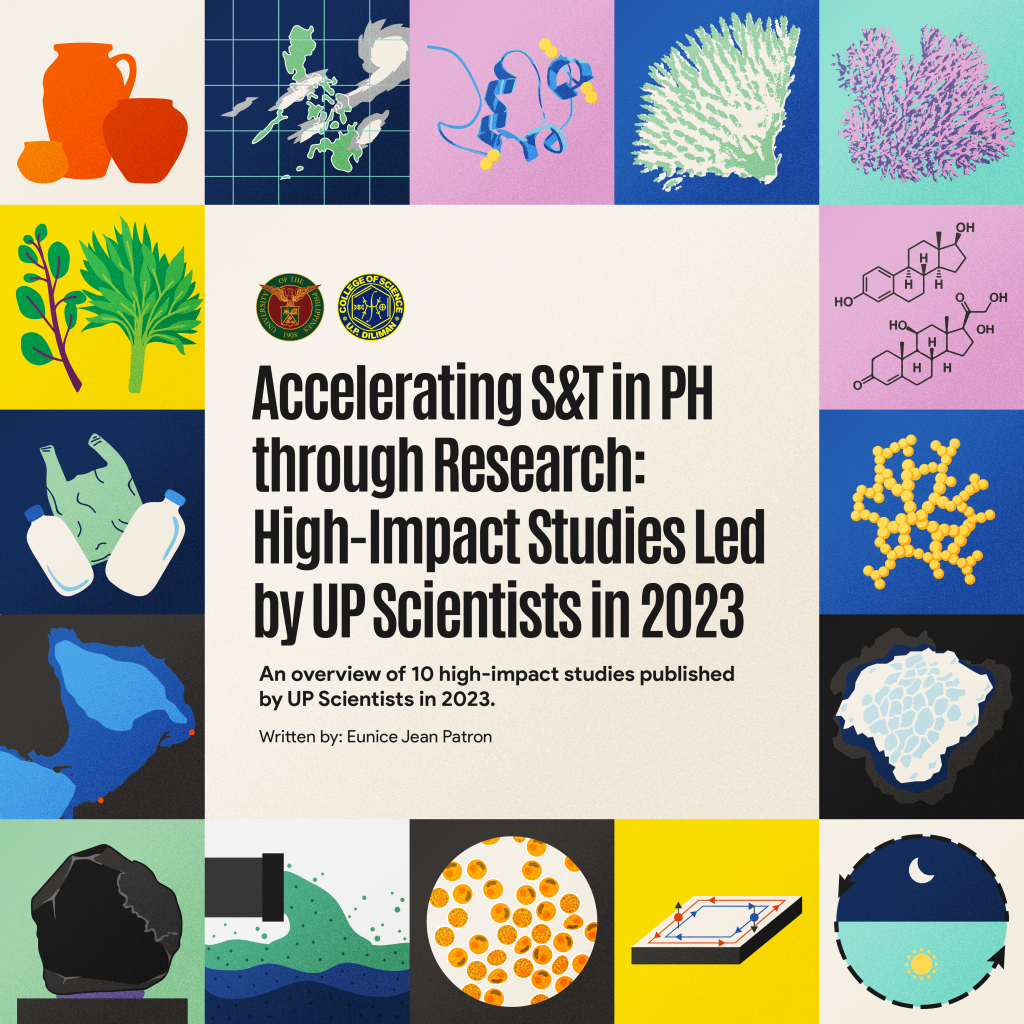
Science and technology (S&T) play a vital role in Philippine development, providing innovative solutions to societal challenges faced by Filipinos. In that regard, the University of the Philippines – Diliman College of Science (UPD-CS) has been at the forefront of advancing S&T in the Philippines for decades, producing basic and applied scientific research of high standards and national relevance. Year after year, research spearheaded by UPD-CS scientists is published in various journals with high impact factors. The impact factor is a variable measuring a journal’s importance based on the average number of citations of its articles.
UPD-CS scientists continued the College’s long streak of quality research in 2023, with several studies they led becoming internationally recognized and included in some of the world’s most notable, high-impact journals. From examining Philippine tropical cyclones to the risk factors of breast cancer, here are some of UPD-CS’ recent scientific breakthroughs contributing to the country’s socio-economic development.
1. Analyzing the effects of pioneer colonizing bacteria on plastic breakdown in oceans
Once released into the environment, plastics become places where bacteria can attach and grow. The bacteria on plastic interact with each other and work differently than those in the surrounding environment, which can affect how plastics break down. However, little is known about specific types of bacteria that are the first to attach and interact with plastics.
Justine Marey Bitalac, Norchel Corcia Gomez, and Dr. Deo Florence Onda of the Marine Science Institute (MSI) studied bacteria from Manila Bay that attach to plastics. Their group identified ten types of bacteria, and the scientists tested their ability to grow on plastic over 60 days. The plastic showed signs of physical deterioration, and chemical analysis revealed that different species of bacteria potentially create varying changes in the plastic’s structure.
Bitalac and Dr. Onda’s research was published in the Journal of Hazardous Materials, a publication featuring articles in the areas of Environmental Science and Engineering. The Journal of Hazardous Materials has an impact factor of 13.6.
2. Detecting harmful dye pollutants using gold nanomaterials
Because of the abundant hot spots in their structure, branch-shaped gold nanomaterials are getting recognized as suitable enhancers for surface-enhanced Raman scattering (SERS), a technique typically used to detect toxic dye pollutants. However, making these nanomaterials usually involves time-consuming experiments that use hazardous and expensive chemicals.
Rufus Mart Ceasar Ramos of the Natural Sciences Research Institute (NSRI) and Dr. Michelle Regulacio of the Institute of Chemistry (IC) created gold nanomaterials using eco-friendly and low-cost organic acids in plants, such as ascorbic acid, oxalic acid, and tartaric acid. Their approach is also convenient, direct, inexpensive, and rapid, taking less than an hour to complete. The resulting branched gold nanomaterials, called nanocorals, also have numerous hot spots similar to the gold nanomaterials.
Ramos and Dr. Regulacio’s research was published in ACS Applied Nano Materials, a publication featuring research covering all aspects of engineering, chemistry, physics, and biology relevant to applications of nanomaterials. ACS Applied Nano Materials has an impact factor of 5.9.
3. Discovering the link between stress, altered light-dark cycles, and breast cancer
Disruption of the body’s 24-hour pattern of biological activity, known as the circadian cycle, is linked to an increased risk of breast cancer. Shift work and constant jet lag, in particular, have been associated with this risk.
In their study, Weand Ybañez and Dr. Pia Bagamasbad of the National Institute of Molecular Biology and Biotechnology (NIMBB) found out that a gene that suppresses tumor growth called the Krüppel-like factor 9 (KLF9) is downregulated in breast tumors compared to normal breast tissue. This gene’s activity is influenced by stress hormones and oscillates with the 12-hour light-dark cycle.
Ybañez and Dr. Bagamasbad’s study was published in Cancer Cell International, a publication featuring studies on cancer cell biology originating from work using laboratory experiments. Cancer Cell International has an impact factor of 5.8.
4. Investigating quantum spin Hall and Rashba effects in flat ilmenite oxides
Inspired by the discovery of an excellent conductor of electricity called graphene, scientists became interested in other two-dimensional (2D) materials that can be used for technological applications. One of these 2D materials is ilmenite oxides.
A group of physicists, including Dr. Genevieve Macam of the National Institute of Physics (NIP), studied the properties of 2D ilmenite oxides with different metal combinations in their original and Janus forms, which are nanoparticles with two distinct surfaces. Their research showed that the different combinations with 2D ilmenite oxides could have applications in spin transport electronics, a branch of electronics that relies on the intrinsic spin of electrons for information storage and processing.
Dr. Macam’s research was published in the Chinese Journal of Physics, a publication featuring research in various branches of physics. The Chinese Journal of Physics has an impact factor of 5.
5. Exploring the potential of Cu2O semiconductors paired with plasmonic metals
Metal–semiconductor nanocomposites, especially semiconductors combined with plasmonic metals like gold (Au) and silver (Ag), can be used for various applications across different fields. These combinations have unique optical properties that arise from their interactions with light and the movement of charge carriers within their structure.
Enrico Daniel Legaspi from the Materials Science and Engineering Program (MSEP) and Dr. Michelle Regulacio of the Institute of Chemistry (IC) examined the pairing of the copper(I) oxide (Cu2O) with Au and Ag. In the review, the scientists detailed the methods and adjustments used to pair the components. The review also explored how these combinations affect the optical and electronic properties of the nanocomposites in the context of photocatalysis, a process where light energy is used to drive a chemical reaction.
Legaspi and Dr. Regulacio’s review was published in Nanoscale Advances, a publication featuring research on nanoscience and nanotechnology. Nanoscale Advances has an impact factor of 4.7.
6. Assessing the response of severe Philippine tropical cyclones to a warmer climate
The Philippines frequently experiences tropical cyclones (TCs), often leading to casualties and significant damage to property due to strong winds, flooding, and rainfall. Understanding how climate change impacts TCs is important, given their socioeconomic consequences.
A group of meteorologists, led by Dr. Rafaela Jane Delfino and Dr. Gerry Bagtasa of the Institute of Environmental Science and Meteorology (IESM), observed how three severe TCs (Haiyan from 2013, Bopha from 2012, and Mangkhut from 2018) might change under future warmer climate conditions through the pseudo global warming (PGW) technique. The simulations show that the three TCs could become more intense with increases in maximum wind speeds. The potential impact of the TCs is also expected to be higher in the future.
Dr. Delfino and Dr. Bagtasa’s research was published in Climate Dynamics, a publication featuring high-quality research on all aspects of the dynamics of the global climate system. Climate Dynamics has an impact factor of 4.6.
Press release: https://science.upd.edu.ph/more-intense-typhoons-to-come-this-century-up-study-warns/
7. Developing a framework for deriving analytic steady states of biochemical reaction networks
Understanding the long-term behaviors of biochemical systems involves looking at their stable states, but deriving these states directly for complex networks can often be challenging. Recent research focuses on network-based approaches, particularly transforming intricate networks of chemical reactions within biological systems into another weaker form. This method, however, can be challenging for larger and more complex networks.
A group of scientists, led by Dr. Bryan Hernandez of the Institute of Mathematics (IM), addressed this difficulty by breaking down complex networks into smaller, independent subnetworks before transforming them. This method provided an effective approach to analyzing and comprehending complex biochemical systems.
Dr. Hernandez’ study was published in PLOS Computational Biology, a publication featuring research focused on understanding living systems at all scales through the application of computational methods. PLOS Computational Biology has an impact factor of 4.3.
8. Examining bottom simulating reflectors in the Manila Trench forearc and its implications on the presence of gas hydrates in the region
Occurrences of gas hydrates in active plate margins have been reported in various locations and have been studied as both a potential alternative energy resource and a threat to methane release. The Manila Trench forearc, close to active margins with likely methane-rich sediments, can be a model to understand gas hydrate formation and the geological preconditions influenced by tectonics and sedimentation processes.
A team of scientists, including Elisha Jane Maglalang, Dr. Leo Armada, Madeline Santos, Karla May Sayen, and Dr. Carla Dimalanta of the National Institute of Geological Sciences (NIGS), conducted the first study that investigates the Manila Trench region for indicators of gas hydrates, laying the foundation for future gas hydrate research in the area and exploring its potential as an energy resource and the geological hazards linked to gas hydrate dissociation in an active margin setting, such as submarine slope failures and methane release to the atmosphere. The scientists also reinterpreted existing seismic data from the Manila Trench to describe bottom simulating reflectors (BSRs), which are considered important seismic markers of the probable presence of gas hydrates.
Their study was published in Marine and Petroleum Geology, a publication featuring research covering marine and petroleum geology. Marine and Petroleum Geology has an impact factor of 4.2.
9. Looking into the hidden diversity and genetic variations in the coral Acropora tenuis and its endosymbionts across the Great Barrier Reef
Genetic research is revealing extensive hidden diversity in reef-building corals, suggesting that the diversity in these key reef organisms is much greater than previously thought. Endosymbiotic algae living inside coral hosts may also help corals adapt to environmental stress, adding another layer of genetic variation that isn’t limited by differences between coral species.
A team of biologists, led by Dr. Ambrocio Melvin Matias of the Institute of Biology (IB), examined the genetic variations in a common reef-building coral, Acropora tenuis, and its associated endosymbiotic algae across the entire Great Barrier Reef (GBR). Their research suggests that the environment plays a vital role in shaping the algae communities living with the corals, which could help them adapt to changes in their environment.
Dr. Matias’ study was published in Evolutionary Applications, a publication featuring research on taxonomic groups – from microbes to plants and animals. Evolutionary Applications has an impact factor of 4.1.
10. Delving into the possible leafy vegetables’ distinctive biomolecular properties included in prehistoric southern Vietnamese cuisine
Vietnamese cuisine is considered one of the healthiest in the world, with the inclusion of leafy green vegetables as one of the factors. The vegetables grow in both terrestrial and aquatic habitats, and they can be further chemically distinguished based on the lengths of their waxy organic compounds. Finding these compounds in pottery vessels as organic residues suggests that ancient people used pottery to prepare these food sources.
A group of scientists, led by Dr. Michelle Eusebio of the Science and Society Program (SSP), conducted an organic residue analysis on sampled pottery vessels from three archaeological sites in Southern Vietnam. Their analysis revealed that Vietnamese people used a specific combination of terrestrial and aquatic leafy vegetables in their cooking. They found a series of mid-to-long-chain fatty acids, alkanes, alcohols, and a wax ester (tetracosanyl palmitate, C40) in the pottery, which hasn’t yet been reported in archaeological pottery samples. This discovery provides new evidence on how ancient Vietnamese people used pottery to prepare and serve plant-based foods.
Dr. Eusebio’s research was published in the Journal of Archaeological Science: Reports, a publication featuring research applying scientific methods to archaeological problems. The Journal of Archaeological Science: Reports has an impact factor of 1.6.
For interview requests and other media inquiries, please contact: [email protected]
UP achieves 100% passing rate in the recent Architecture Licensure Examination
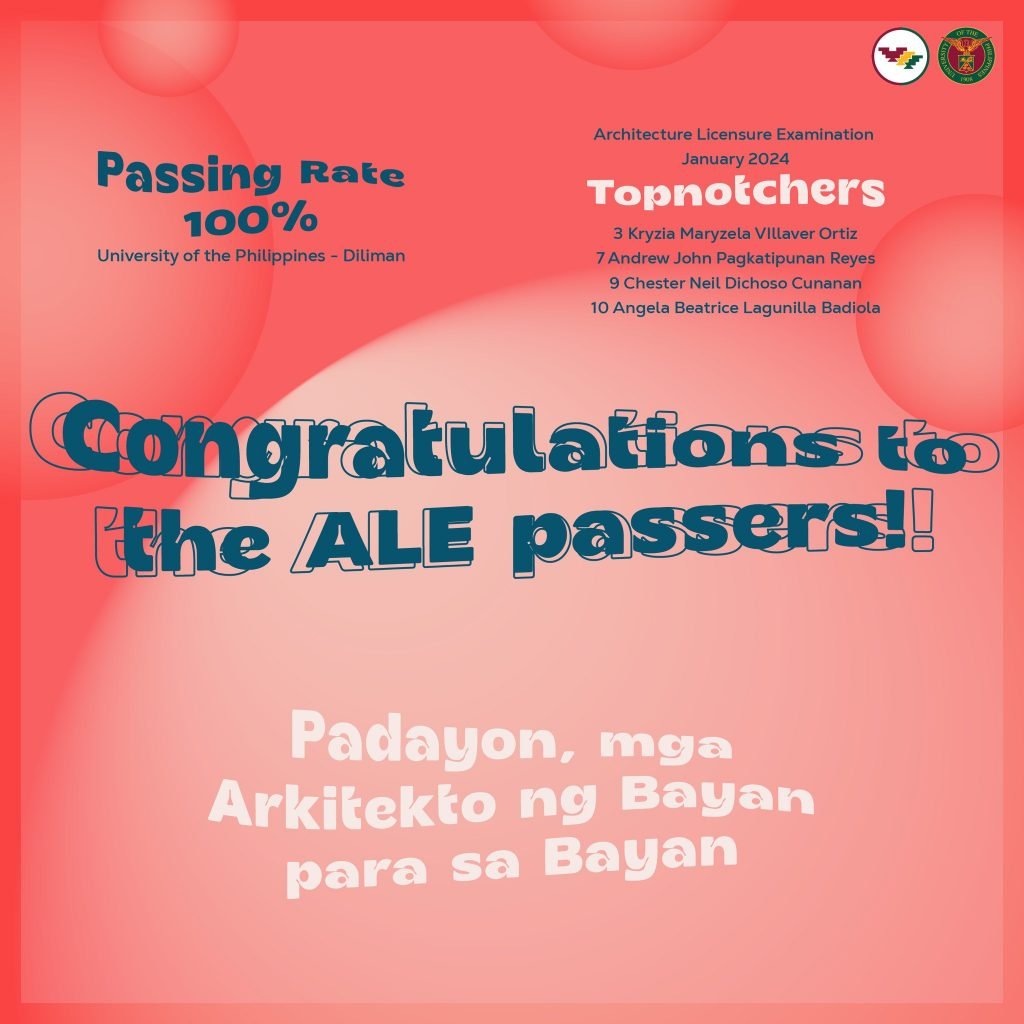
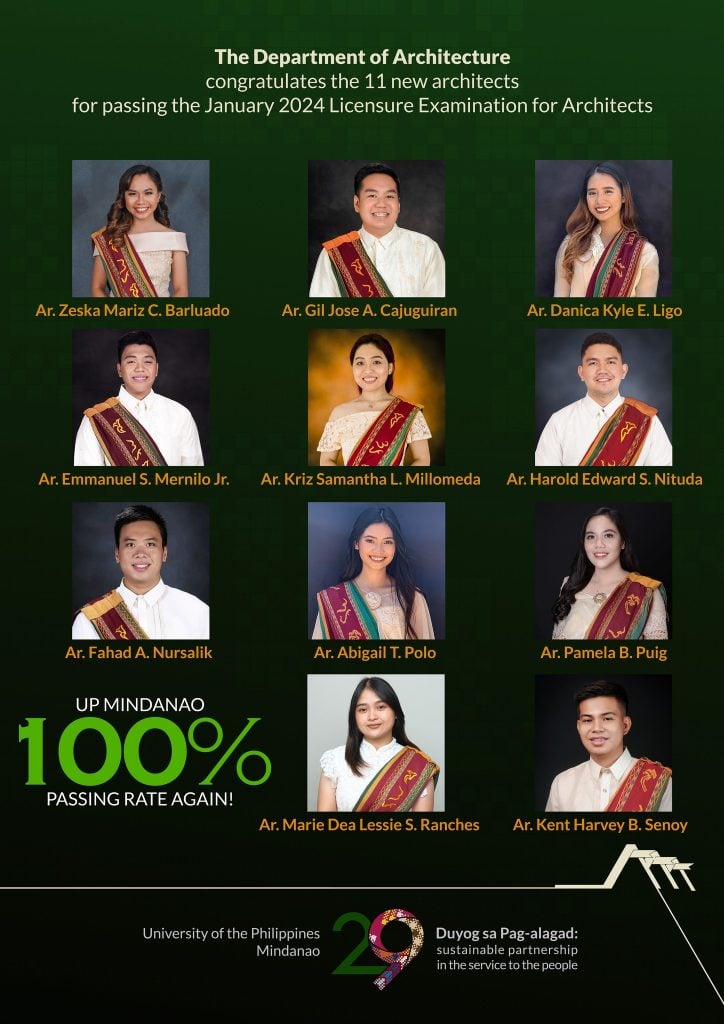
Twenty-six examinees from UP Diliman and 11 examinees from UP Mindanao achieved a 100 percent passing rate in the January 2024 Licensure Examination for Architects given by the Professional Regulation Commission (PRC) on January 24 and 26, 2024.
Four graduates from UP Diliman entered the top 10 list: Kryzia Maryzela Villaver Medina placed third with a score of 84.70 percent. Andrew John Pagkatipunan Reyes placed seventh with a score of 83.60 percent. Placing ninth and tenth in the list, respectively, are Chester Neil Dichoso Cunanan, with a score of 83.20 percent, and Angela Beatrice Lagunilla Badiola, who scored 82.90 percent.
The PRC released the results three working days after the last day of examination.
Lani Maestro’s No Pain Like This Body…”: One of the Best Public Art of 2023

The art and design fabrication company Urban Art Projects recently presented its 2023 list of the 12 standout public art projects of 2023, “chosen for their impact”, in partnership with internationally recognized curators. In the Artsy Editorial, UAP curatorial director Natasha Smith said that the 2023 selection “is incredibly sensitive, beautiful, and of the ‘now.’ Themes center on revealing truths; truths about places, histories, cultural erasure, sexual and racial inequality, and war. However, all is not lost. Light is also a theme that shines through as a call to undertake restorative discourses that enable shared learnings. It is certainly a thought-provoking collection of incredible public artworks for 2023.”
The curators were Dina Amin, curator and CEO of the Visual Arts Commission; Tairone Bastien, an independent curator based in Toronto and assistant professor at Ontario College of Art and Design University; Hedwig Fijen, founding director of Manifesta; Nora Lawrence, artistic director and chief curator of Storm King Art Center; and Nathan Pōhio, artist and senior curator of Māori Art at Auckland Art Gallery Toi o Tāmaki and co-vice president of Te Ūaka Lyttleton Museum.
Among the best public art of 2023 selected by the curators is Lani Maestro’s No Pain Like This Body, No Body Like This Pain. Tairone Bastien wrote of his visit to the site: “The most incisive public artwork I experienced this year was a text-based installation by Lani Maestro… at the Vancouver Art Gallery’s Offsite location in the city’s Financial District, first installed in 2022. High above me, two red neon signs glowed with the work’s title. The twin phrases gave me pause, piercing the night like a violence that felt out of place with the artwork’s surroundings. Maestro is well known for minimal yet provocative text-based works that are site responsive, unearthing a place’s resonant histories and narratives.”
“The two brief lines poignantly address human suffering, which is a terrifying condition that sharply contrasts with the work’s sterile and muted environment—a business district of characterless hotels, office towers, and high-end boutiques. This is some of the costliest real estate in one of the most expensive cities in the world and is, no doubt, under constant surveillance and policing. It’s a dehumanizing façade that belies the reality of Vancouver’s most vulnerable populations who are marginalized and invisibilized yet inextricably part of the city.”
“The full power of Maestro’s work is its ability to bridge these two sides of the city. Dispelling the myth of Vancouver, often celebrated for its natural beauty and high standard of living (for some), is vital, and hopefully a dynamic way forward for public art in the city.”

Bottom: L-R: Artwork with reflection on the water below; Artwork Reflection on the mirrors of the hotel’s lobby nearby; Another view of the offsite artwork. Photo credits: Lui Queano
Lani Maestro is a multi-awarded Filipino-Canadian artist who divides her time between Canada, the Philippines, and France. She works in installation, sound, video, bookworks, and writing. She has a Bachelor of Fine Arts from the University of the Philippines and a Master of Fine Arts from the Nova Scotia College of Art and Design. In 2018, she received an Honorary Doctorate Honoris Causa from NSCAD University in Canada.
The UAP’s Best Public Art for 2023 were made by artists in public places around the globe: Queens and Manhattan, New York; London, England; Vancouver, Canada; Pristina, Kosovo; Osnabrück, Germany; Ōtautahi Christchurch, New Zealand; Sydney, Australia; and Sharjah, United Arab Emirates. The images and descriptions are found here.
Written by PA Correspondent
Source: https://pinoyabrod.ca/lani-maestro-urban-art-projects-best-public-art-of-2023
UP Baguio graduate earns McCall MacBain Regional Award

University of the Philippines Baguio graduate earns McCall MacBain Regional Award.
University of the Philippines Baguio graduate Khianne Orteza (BSc’23) has earned a C$10,000 McCall MacBain Regional Award. This scholarship recognizes engaged student leaders who have demonstrated exceptional character, community engagement, leadership potential, entrepreneurial spirit, academic strength, and intellectual curiosity. It provides funding for a full-time master’s or professional program at any public university in Canada.
Khianne recently graduated magna cum laude from University of the Philippines Baguio, where he majored in microbiology and co-authored a research paper on biotherapeutics as treatment for skin conditions. He participates in a volunteer program, conducting workshops at under-served schools in the Cordillera, and assists patients at an HIV clinic. Khianne also helped raise funds for a sustainability initiative and contributed to a teletherapy service. One of his most significant leadership experiences was initiating a science training program during an internship in 2019. Khianne is applying for master’s programs in microbiology and related fields.
“The McCall MacBain Regional Award fuels my drive in connecting science with people’s lives through education,” said Khianne.
Khianne placed among the top 50 of international applicants from 2,250 universities. He is one of the first two Philippines university graduates selected for the program.
The McCall MacBain Scholarships are the result of a landmark C$200 million gift in 2019, then the largest single donation in Canadian history, by John and Marcy McCall MacBain.
Applications will open in June 2024 for September 2025 admission. In addition to 30 fully funded scholarships, up to 100 awards of C$5,000 to $20,000 will be offered. More information about the McCall MacBain Scholarships can be found at mccallmacbainscholars.org.
Congratulations Khianne Orteza
Source: UP Baguio Facebook
